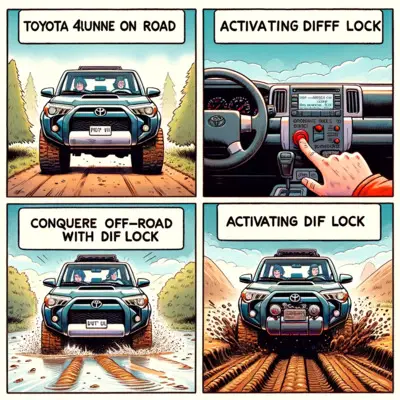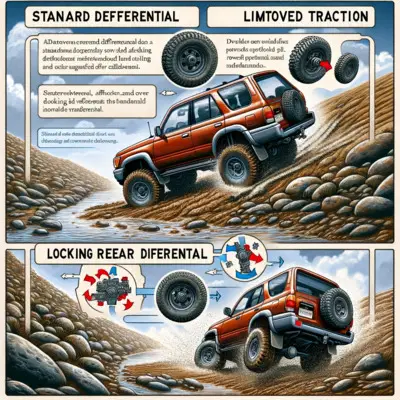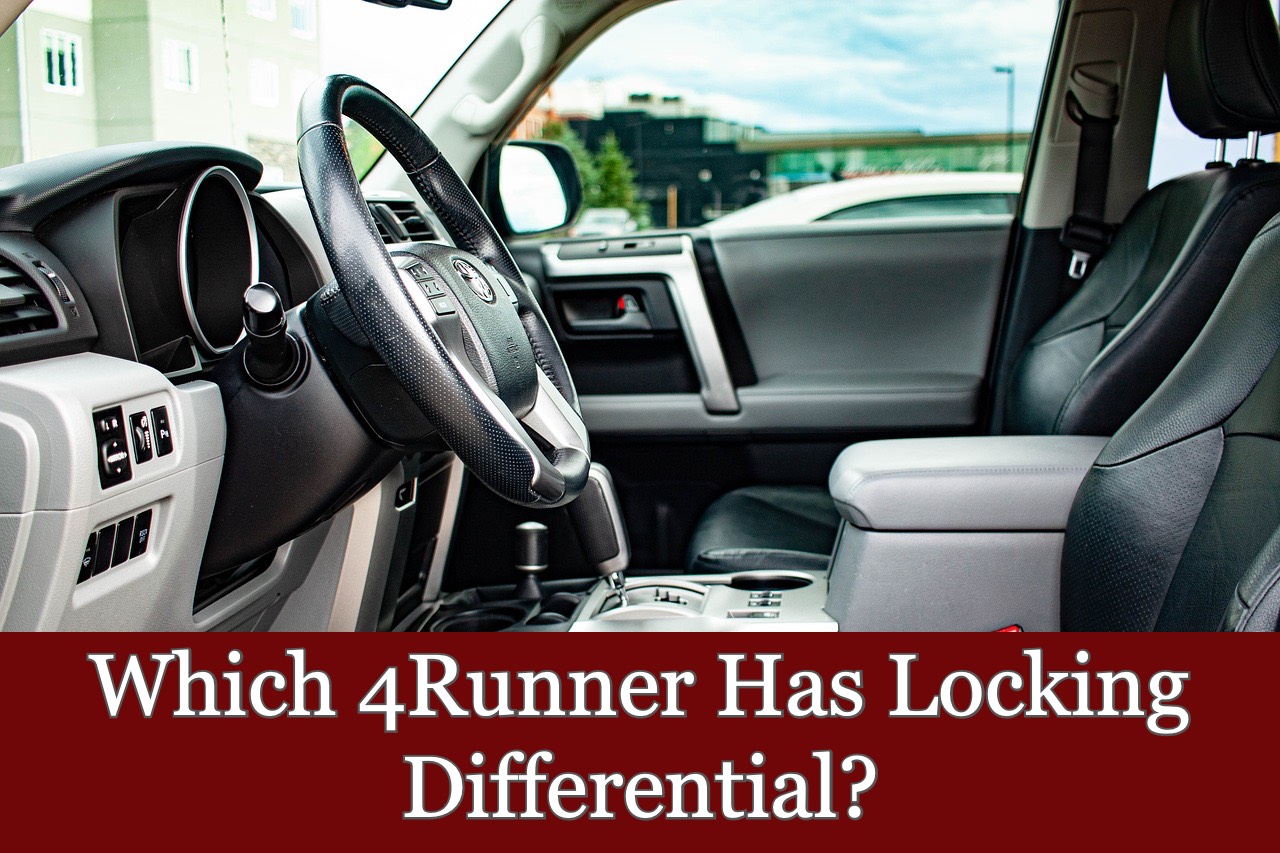Toyota introduced the Toyota 4Runner model in 1984. Since then, the beautiful SUV has been known for more than three decades as a vehicle for the adventurous individual. Over the years, automobile manufacturers have continued to provide new features to make the 4Runner appealing to a wider population of customers.
While upgrading the comfort level of this SUV, automobile manufacturers have retained the vehicle’s 4×4 frame design, making it durable enough to handle any challenge. When it’s about challenges, off-road driving comes first, where you may need additional traction and balanced power.
Thankfully, Toyota has integrated locking differential with some particular 4Runner models that help to conquer the hardest terrain. So, if you’re an off-road enthusiast, you might be wondering which 4Runner has a locking differential. Just stick to our article till the end.
A Brief Story Of Toyota 4Runner

The Toyota 4Runner is a small- to medium-sized sport utility vehicle released by the Japanese company Toyota and sold throughout the world from 1984 to the present. In Japan, it is known as the Toyota Hilux Surf.
The first-generation 4Runner was a compact SUV and little more than a Toyota Hilux pickup truck with a fiberglass shell over the bed, but the model has since gone through significant changes to serve as a crossover between a midsize sedan and a compact SUV.
All of the 4Runners were manufactured in Japan at the Toyota factory in Tahara, Aichi, or at Hino Motors (a Toyota subsidiary) in Hamura. For the 2014 model year, the Toyota 4Runner received a facelift, with revised front and rear fascias along with projector headlamps and clear-lensed, LED taillamps, among other minor cosmetic changes.
The interior was also up-to-date, with soft-touch door trim, leather-wrapped steering wheel and shift knob, revised dashboard, and center stack, and the inclusion of iPod, USB, and auxiliary inputs.
Which 4Runner Has Locking Differential?
So, which 4Runner models come with a built-in locking differential? Well, You will find the locking rear differential only on the Trail, TRD Off-Road, and TRD Pro 4Runner models.
The locking rear differential offers great effectiveness to an already capable vehicle. It’s astounding to think that you can get a stock car with a HI-LO transfer case, Crawl Control, Multi-terrain Select, A-TRAC, and a locking rear differential. This is an excellent selection that is absolutely hard to beat for an all-terrain vehicle like the 4Runner.
How Does The Locking Rear Differential Effect the Toyota 4runner?

The rear locker can guarantee that a half-wheel on either side will have the same amount of power split evenly and at least one wheel in the front will have power. Regardless of whether you ride a standard bicycle or a tandem bike, the rear locker ensures you’re guaranteed to have at least two wheels with 25 of the total power applied to each rear tire and at least 50 of power applied to each front tire.
In challenging off-road locations, it could prove difficult to utilize a locker, even continuously. You don’t want to leave your vehicle on slippery surfaces that have superior traction, as this can cause damage to the drive train. If you turn, the outside and inside wheels turn in different directions.
When you safely lock the rear axle, the car can’t suddenly gain the capability to have an outside tire spinning at a faster speed than the inside tire. The locker should only be used when your tires are resting on loose and low-traction surfaces.
When selecting your 4LO system with the 4-TRAC, and your locker, you’ll have the power and capability for some pretty serious off-roading.
When To Use Rear Lock Differential On 4Runner?
The rear differential lock system is preferably used for the rear wheels only if the wheels spinning in a place that includes a ditch or a slippery surface. The rear differential lock system is helpful only when the rear wheel stops spinning.
So, have to use the locking differential when you’re heading to difficult terrains such as mud, snow, dirt, or gravel. In these types of surfaces, a locking differential provides additional traction that safeguards your 4Runner and yourself. So, you should prefer using the differential locker only in off-road conditions.
At this time, the rear differential lock indicator will flash. Wait a few seconds for the system to complete operating. When the back differential is locked, the indicator will stop flashing and remain on. To unlock the back differential, push the switch again.
How To Use Rear Differential Lock System
To reap the maximum benefit of the rear differential lock system, you have to know the appropriate procedure. Here are some tips on this:
- Before using the rear differential lock mechanism, stop the vehicle, counterclockwise rotate the ignition position knob until the hyphen is in the lower-right position, and after that shift the shift lever to N and push the transmission release lever into L4 to see if this fixes the problem. However, if this doesn’t fix the situation, use the depth differential brake mechanism.
- Make sure all wheels have stopped turning.
- Now crank the rear differential lock switch.
- Gently depress the accelerator pedal. Back off on the rear differential when the indicator indicates that it is locked, as described above.
- Unlock the rear differential as soon as the vehicle starts to move. To unlock the rear differential, press the button once again.
Why Is Your Diff Lock So Important?
The diff-lock function uses different friction levels on all wheels so that any wheel that experiences the loss of traction will spin at preselected speeds. This is beneficial if you face rough terrain and one or more wheels unintentionally tilt away from the ground, consequently retaining full power in order to facilitate movement in the direction the car is headed.
Envision that you’re driving over rough terrain with one wheel sliding away from the surface of the ground. This wheel may have the most driving power (or give it the best chance of doing so) compared to the others since it can drive over rough terrain with the greatest degree of traction.
A locking differential empowers the power transmission to this wheel while minimizing the power that the other wheels receive, improving your forward thrust.
Therefore, your differential lock is a crucial part of your vehicle’s antilock braking system, which helps you prevent wheel spin in both dangerous driving conditions, such as snow or ice, and convenient driving conditions alike.
When To Use Off-Road Features On Your 4runner?
There are many features to take into account. How do you decide what to climb? We will give you my advice on what my opinion is in this area, excluding Crawl Control and Multi-terrain Select, as these are really user-determined choices, and adding these two features nearly ensures an infinite number of choices for what mode to be in.
Snow, Ice, or Mud on Paved Road
If you plan on driving on a paved road that has a slick surface because of mud, snow, or ice, you’re best served using 4HI. Dirt and gravel roads that are slick are also good options. 4HI allows you to journey much faster than normal, so it’s important to use logic when driving it.
You will have the capability of having a throttle applied to your steering, which means you will have the capability to be directly pulled over the road you’re driving. You will have more effective steering input and more speed. If you are driving at a speed of between 40 and 55 miles per hour, the 4H designation stands as a way to apply your top speed.
It is useful to note that there is no guarantee that you should shift into 4H at speeds of between 40 and 55 miles per hour and still minimize damage. You should always stay in 2HI whenever appropriate to prevent accidents.
Thick Snow or Mud
You need more torque and traction control in mud and snow, as thick snow or mud demands more torque or traction control than what the vehicle is turned on for. Keeping your traction control turned on will result in your vehicle continually attempting to reduce power, and this will result in a loss of momentum.
Thankfully, 4LO automatically eliminates traction control. 4LO automatically signals tablecloths to the federal government and eliminates the traction control it has under those drivers. 4LO helps you to acquire better torque, which aids you in negotiating the streets with greater dependability of movement.
Steep Inclines
Steep inclines are a sure calling for 4LO, and you will have more than enough torque to climb and will be in the best possible control of your vehicle. The small rocks and pits or large ridges will also help to boost the curve’s handling and increased capability.
Like the rear differential, the A-TRAC will increase your chances of making it, and stable stabilization would be our next choice.
Final Words
You might have learned about which 4Runner has a locking differential. Now it’s time to make your decision. We have also tried to explain some other off-road settings that will guide you in difficult conditions.
